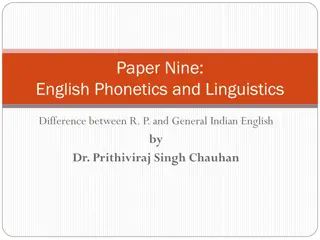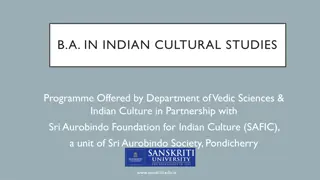
Anita Desai's Unique Literary Style and Influences
Explore the fascinating blend of influences from Virginia Woolf and Jane Austen in Anita Desai's works, delving into themes of imperfect marriages, familial ties, identity, and complexities in relationships. Discover how Desai's innovative narrative techniques, such as fractured chronology and interior monologue, challenge conventions and offer a feminist critique through a modernist lens.
Download Presentation

Please find below an Image/Link to download the presentation.
The content on the website is provided AS IS for your information and personal use only. It may not be sold, licensed, or shared on other websites without obtaining consent from the author. If you encounter any issues during the download, it is possible that the publisher has removed the file from their server.
You are allowed to download the files provided on this website for personal or commercial use, subject to the condition that they are used lawfully. All files are the property of their respective owners.
The content on the website is provided AS IS for your information and personal use only. It may not be sold, licensed, or shared on other websites without obtaining consent from the author.
E N D
Presentation Transcript
Mohanlal Sukhadia University Department of English INDIAN WRITING IN ENGLISH Fire on the Mountain Fire on the Mountain Anita Desai Submitted by : Riddhi Katariya M.A. English (Semester-I) Paper : V Indian Writing in English (MAE/1/CC/05) Submitted to: Prof. Seema Malik Title : Anita Desai as an Indian Blend of Virginia Woolfand Jane Austen 1
Virginia Woolf Virginia Woolf Born: Adeline Virginia Stephen Brought up and educated at home in London: she had free access to her father's rich library In 1895, she had the first nervous breakdown caused by her mother's death In 1904, she moved with her sister Vanessa, and the two brothers to a house in Bloomsbury : the house became a meeting place of a group of intellectuals called THE BLOOMSBURY GROUP 1882-1941 2
She began writing professionally in 1905 1912 : married Leonard Woolf Her first novel "The Voyage Out" was published in 1915 She is an important modernist writer One great innovators in English language In 1941, she committed suicide by drowning herself She experimented with: - Stream of consciousness : it is a narrative method that attempts "to depict the multitudinous thoughts and feelings which pass through the mind - Underlying psychological and emotional motives of the characters : shewas a very serious and conscious artist, interested more in minds, sensation, thoughts, feelings, intuitions, than in the life of external action 3
- Breaking conventions : we can see there is a constant sense of searching for a new ways of representing the world and of thinking about people and their experiences -Fractured narrative and chronology: she presents her story from the middle, flashing backward and forward revealing the entire story - Feminist movement : her novels and essays consists a highly ground breaking feminist critique of the exclusion of women from economic independence and education - Interior Monologue - to convey the feelings and emotions Themes - Imperfect marriage - Familial ties - Identity (of women in particular) - Complexities of man-woman relationships -Use of time, memory and space - Death 4
Her most famous works include : -Mrs. Dalloway (1925) one of the most well known novels, addresses the moral dilemma of war and its effects and provides an authentic voice of soldiers returning from World War I -To the Lighthouse (1927) considered as a peak of the Modernism, the plot centers on Ramsay family s anticipation of and reflection upon a visit to a lighthouse and the connected familial tensions ,the shifting perspective of each character s consciousness is unique - the Orlando (1928) a biography, one of her lightest novels of a young nobleman who lives for three centuries without ageing and - the Waves (1931) presents a group of six friends akin to a prose poem 5
Jane Austen Jane Austen She was a born in Steventon, Hampshire, England Seventh of the eighth child Apart from three years of school, she was educated at home along with her sister At the of 12, she was writing amusing and instructive parodies and variations on 18th century literature- from Sentimental novels to serious histories First Trilogy In 1801, the family moved to Bath followed by Chawton Second Trilogy Published her work under the pen name By a Lady She led a secluded life Died at the age of 41 1775-1817 6
She experimented with : - Parody and Burlesque : : her characters lack common sense which is characterized by mocking, imitation and exaggeration - Irony and Satire : She critiques marriage market and illuminates the foibles of individual characters and her society -Realism : focuses on everyday relationships in the most trivial incidents of everyday life - Comedy of manners : Comedy of Manners has its roots in the 17th century. The plays are set in aristocratic society and ridicules them with dialogues. The form has mostly been used by the playwrights and the characters portrayed are the fool, jealous husband etc. The masters of this form are : William Wycherley (The Country Wife) and William Congreve (Way of the World) etc The traces of this form can be seen in Emma Characters and language : her characters belong to landed gentry and there is a little scenic description and they contain more of dialogues - Education and reading - Morality - Religion -Gender (the position of women, in particular) - Class background - Politics - Role of colonialism Themes 7
Her most famous works include : - -Sense and Sensibility (1811) the satirical, comic work offers a vivid depiction of 19th century middle class life -Pride and Prejudice (1813) a romantic novel follows Elizabeth Bennett and the conflict following her and her sisters quest to get married and produce a male heir - Mansfield Park (1814) third novel which deals with Fanny s relationship with Edmund -Emma (1816) is a comedy of manners depicting the lives and challenges of society women living in Georgian, Regency England, centering on Emma Woodhouse who makes matches between her friends and acquaintances for amusement - Northanger Abbey (1818) asatirical novel which follows a young clergyman s daughter named Catherine Morland, who visits her wealthy neighbors to participate in a season of balls - Persuasion (1818) -tells the story of Anne Elliot and her relationship with Captain Frederick Wentworth which ends, then picks back up again after many years 8
Anita Desai Anita Desai Born: Anita Mazumdar to a (German)mother and (Bengali) father Grew up speaking many languages She was a student at Queen's Mary, Delhi Earned a Bachelor of Arts from Miranda House In 1958, she married Ashwin Desai, the director of a computer software company and author of the book Between Eternities : Ideas on Life and the Cosmos They have four children, including Booker Prize winning novelist Kiran Desai She is a novelist and a professor at Massachusetts Institute of Technology She has received many prestigious awards for her novels Sahitya Academi Award (1978) Shortlisted, Booker Prize for fiction (1980) British Guardian Prize (1983) - - - 1937- 9
Her most famous works include : - Cry, the Peacock (1963) - Voices in the City (1965) - Bye-bye Blackbird (1971) - The Peacock Garden (19474) - Where shall we go this summer ? (1975) - Cat on a Houseboat (1976) - Fire on the Mountain (1977) - Games at the Twilight (1978) - Clear light of the day (1980) - The Village by the Sea (1982) - The Custody (1984) - Baumgartner s Bombay (1988) - Journey to Ithaca (1995) - Fasting, Feasting (1999) - Diamond Dust and Other Stories (2000) - The Zigzag Way (2004) - The Artist of Disappearance (2011) 10
- Inner realties and psyche reverberations: she explored the modern idea of Sensibility - Contemporary issues: the hazards and complexities of man-woman relationships - Identity: the founding and nurturing of individuality and the establishing of Individualism - Characters: mostly females, highly sensitive but sequestered in the world of dream and imagination and alienated from their surroundings - Stream of consciousness: she tries to unfold the protagonist s mind to her readers Experimented with Themes -Desai is considered the writer who introduced psychological novel in the tradition of Virginia Woolf in India -She is a pioneer of writing on feminist issues in India -She has covered themes such as women's oppression and quest for a fulfilling identity, family relationship and contrast, the crumbling of traditions and anti-Semitism include neurotic -Mental and spiritual development -Marriage -Escapism -Isolation 11
Virginia Woolf Jane Austen Anita Desai British, 20th century Modernist writer Writing style : - Stream of consciousness - Feminist movement - Breaking conventions - Interior Monologue - Realist British, 18th century Romantic writer Writing style : - Comedy - Wit and Satire - Realist Indian, 20th century Modernist writer Writing style : -Stream of consciousness - Feminist movement - Breaking conventions - Interior Monologue - Realist Themes : - Imperfect marriage - Identity (of women in particular) - Complexities of man- woman relationships - Use of time, memory and space - Escapism - Familial ties - Death Themes : - Imperfect marriage - Identity (of women in particular) - Complexities of man- woman relationships Themes : -Imperfect marriage - Identity (of women in particular) - Complexities of man- woman relationships - Use of time and memory - Escapism Characters : - Neurotic females Characters : - Landed gentry Characters : - Neurotic females 12
Conclusion Conclusion Virginia Woolf, Jane Austen and Anita Desai are great artists in the realm of fiction. They are rooted in totally different milieus, yet their works share in common the niche, structure, themes, style and techniques. Like Jane Austen, Desai confines to the two inches of ivory as far as the social milieu and characters are concerned and like Virginia Woolf, Anita Desai maps the inner working of the mind. The mentioned writers have their thematic nexus on the complexities of man-woman relationship and the role and status of women in the changing society which binds them together in a strong bond. Though these writers are from different centuries and countries, they share a lot in common. In the end, it can be said that Anita Desai is an Indian blend of the two British writers i.e., Virginia Woolf and Jane Austen respectively. 13
Works Cited Works Cited Dalmia, Yashodhara: 1979. An Interview with Anita Desai The Times of India, 29 April. Gilbert Ryle. 1986. Jane Austen and the Moralists. Monique Nathan, Virginia Woolf, Evergreen Books Ltd., London, 1961, p20 14
Thank You Thank You 15






















